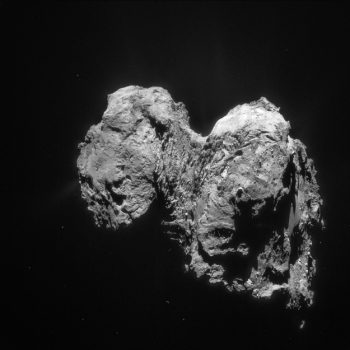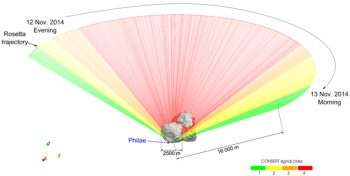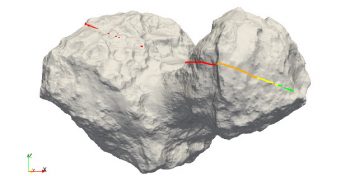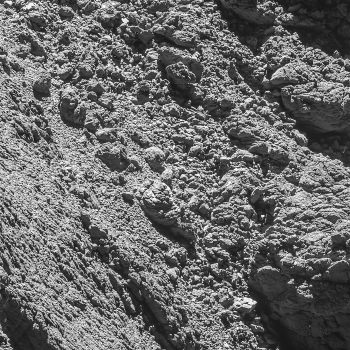While scientists and the public alike have been astounded by the unexpected shape of Comet 67P/ Churyumov-Gerasimenko’s nucleus, what lies beneath the surface is just as important scientifically.
Comet interiors preserve a unique record from the formation of the Solar System 4.6 billion years ago. Reaching that information was one of the key tasks of Rosetta and Philae. There were two principal experiments designed to ‘see’ inside the comet’s nucleus: the COmet Nucleus Sounding Experiment by Radio-wave Transmission (CONSERT) instrument and the Radio Science Investigation (RSI).

Image taken with the navigation camera (NavCam), 28 January 2016. Credit: ESA/Rosetta/NAVCAM, CC BY-SA IGO 3.0
Comets are known to be mixtures of dust and ice. Yet puzzlingly, measurements show that 67P/C-G’s density is much lower than ice. This means the comet has a high porosity, and could be an indicator that there are huge empty caverns inside it. However, neither CONSERT nor RSI find any evidence to support this.
Instead, the investigations have shown that the porosity comes about because the comet is a more or less uniform mixture of ice and ‘fluffy’ dust grains, rather than a honeycomb structure featuring large voids.
CONSERT works by ‘sounding’ the comet’s nucleus. This involves beaming radio waves through the comet from Philae to the orbiter.
“We know the characteristics of the signal used for the sounding. After propagation through the nucleus the signal is received by Rosetta and the way it has been modified provides information about the nucleus’ interior,” says Valérie Ciarletti, LATMOS, Guyancourt, France, and co-investigator on CONSERT.

This diagram shows the propagation of signals between Rosetta and Philae through the nucleus of Comet 67P/Churyumov-Gerasimenko, between 12 and 13 November 2014. Green represents the best signal quality, decreasing in quality to red for no signal. Credit: ESA/Rosetta/Philae/CONSERT

This image shows the path on the comet’s surface where waves transmitted by Philae during the First Science Sequence, between 12 and 13 November 2014, emerged from the nucleus. Green represents the best signal quality, decreasing in quality to red for no signal. Credit: ESA/Rosetta/Philae/CONSERT
As the waves pass through the comet they are slowed down by the ice and dust they encounter. When they are detected by Rosetta, the delay in their transmission and the way the radio pulse’s shape has changed allows the team to compare the results with theoretical models of the comet interior to see which fits the data best.
This work shows that the comet’s low density might be an intrinsic property of the material that makes up the interior. For example, instead of being a compacted solid, the dust in the interior is ‘fluffy’. This fits with the kind of dust grains that Rosetta’s COSIMA and GIADA instruments have detected being given off by the comet.
CONSERT’s results are backed up by those of RSI. Situated on Rosetta, the instrument measures the distribution of mass inside the comet based upon the way the comet’s gravity pulls the orbiting spacecraft. The movement is measured by changes in the frequency of the spacecraft’s signals when they are received at Earth.
It is a manifestation of the Doppler effect, which is produced whenever there is movement between a source and an observer. This same effect causes emergency vehicle sirens to change pitch as they pass by.
The variations in Rosetta’s signals were analysed to give a picture of the gravity field across the comet. Large internal caverns would have been noticeable by a tell-tale drop in the spacecraft’s acceleration. Again, no such signal was recorded.
What does the comet’s shape tell us?
When the strange shape of the comet was first seen by Rosetta, scientists began asking whether the two lobes of 67P/C-G started as two different comets that collided at low speed and stuck together, or if it is the result of erosion caused by the nucleus activity trigged when the nucleus gets closer to the Sun.
Images from the OSIRIS camera show the two lobes appear very different and so are almost certainly two different bodies. On-going analysis with CONSERT data is further investigating this idea.
The instrument was active during Philae’s descent and the scientists measured not only the direct signal between Philae and Rosetta, but also its reflection off the surface of both lobes. Current work is aiming at an accurate analysis of the reflection signal. This will allow the surface properties of each lobe to be compared, which in turn will provide further insight into whether or not these two lobes originated as separate entities.

The lander was identified at the far right of the image, just above centre. Credit: ESA/Rosetta/MPS for OSIRIS Team MPS/UPD/LAM/IAA/SSO/INTA/UPM/DASP/IDA
Now that Philae’s location is known, it confirms the scientists’ suspicion that all CONSERT data received so far has been propagating only through the comet’s smaller lobe. This could well be because Philae came to rest on its side and so the antenna was not in the expected orientation, namely sitting horizontal to the surface. Being on its side has meant that there is a mismatch between the antennas on Philae and Rosetta, hence the signal was probably not strong enough to pass through the bulk of the larger lobe as well.
“Now that we know precisely where Philae is and, most of all, its attitude as well as the very close environment, we are able to simulate the whole radio link from Philae to Rosetta. We might understand if the antenna’s configuration is the explanation for the non-detection or if we need to also consider attenuation inside the larger lobe’s nucleus to explain why we did not detect any signal,” says Ciarletti.
Probing the surface layers
The effect of the Sun’s heat has had a major impact at the surface layer of the comet. Philae has already shown that the surface of the small lobe is different from the interior. The propagation of the radio waves from CONSERT is driven by the permittivity of the nucleus, which is an electrical property governed by the comet’s composition, porosity and temperature. Philae also measured the surface permittivity using its Surface Electric Sounding and Acoustic Monitoring Experiment Permittivity Probe (SESAME-PP) instrument.
This shows that at Abydos, the location where Philae has come to rest, the top metre of the surface has a significantly higher permittivity than the interior, which is consistent with a lower porosity at the surface. This indicates that the surface layers are more compacted than the interior.
There is even more science to come as Rosetta is guided to its controlled impact with the comet on 30 September. The radio link to Earth will mean that RSI continues collecting data right to the very end. The closer the spacecraft gets the comet, the deeper in its gravity field it will be and the better the precision of the readings.
Thanks to the Rosetta and Philae mission we now know 67P/C-G better than any other comet – both inside and out.
—
Insights from the Rosetta mission into what lies beneath the comet’s surface were presented by Valérie Ciarletti during today’s science briefing at the European Space Operations Centre (ESOC) in Darmstadt, Germany.









Discussion: 3 comments
Thanks, Karen, for that quick update.
Porosity ‘intrinsic’ to the resolution of CONSERT. Then the model still needing some poshing. Even if few data. It’s precise.
[Maybe Coraline -just Her- was already fully formed, and part of the ISM, at our Sun’s protodisk dawn].
[Failed moon debris?]